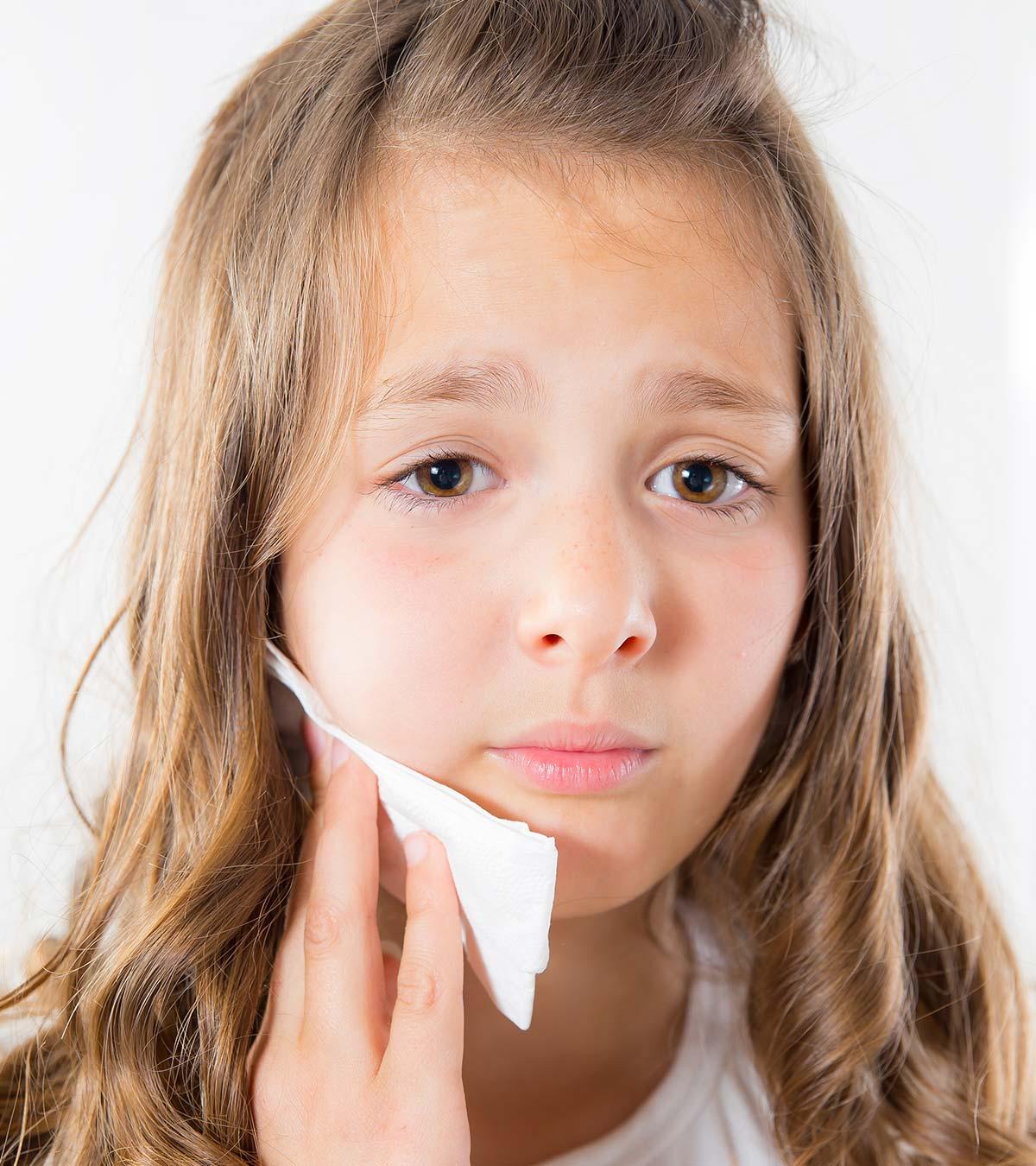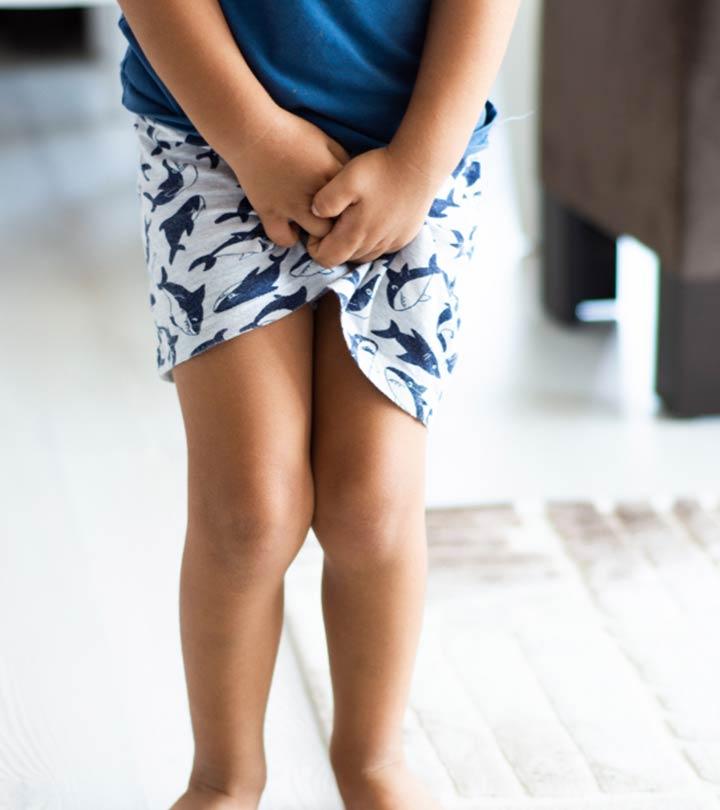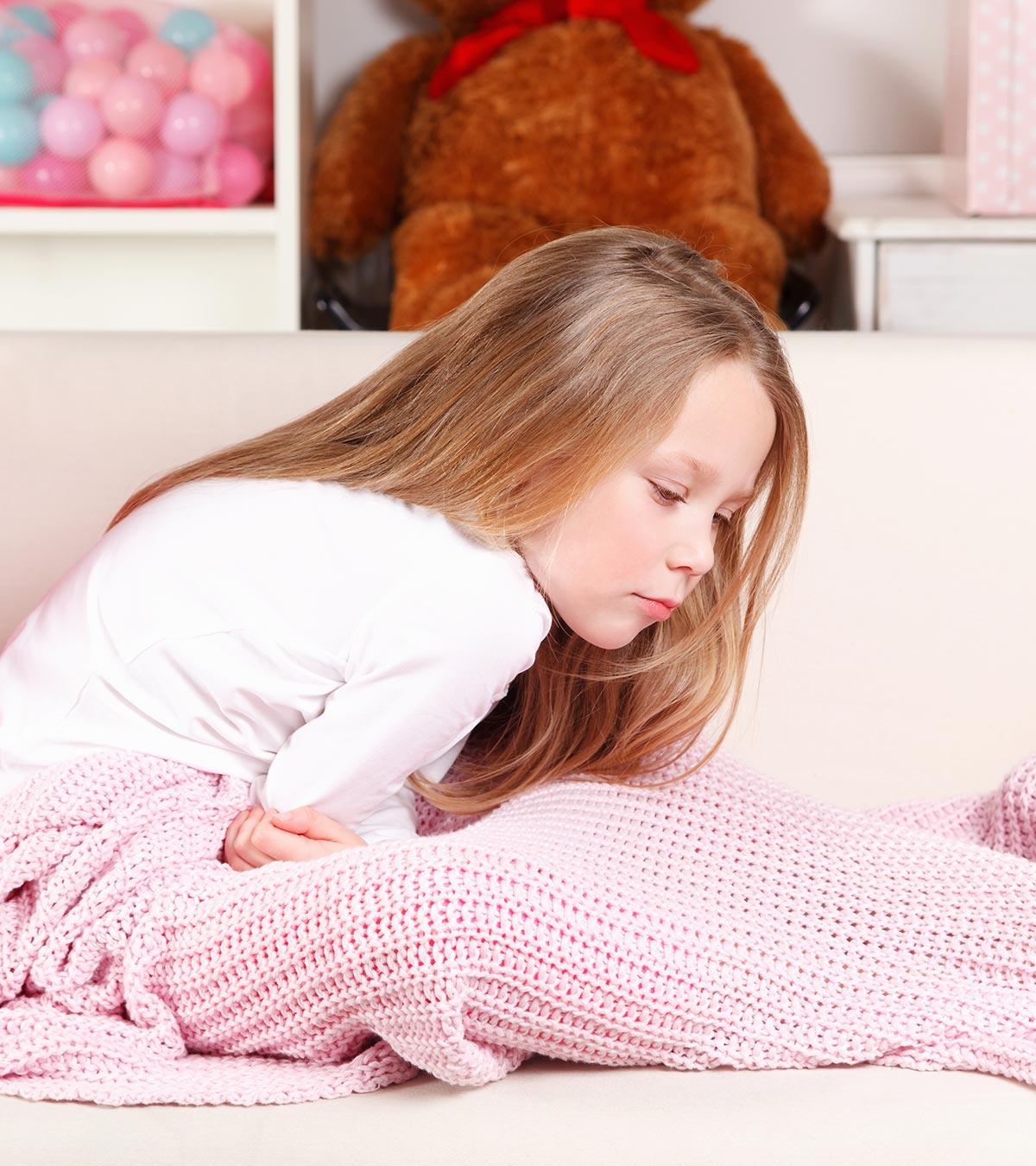
Image: Shutterstock
Excessive sweating in children, which is not related to physical activity or climatic conditions, can be concerning.
It is also called hyperhidrosis. Sweating is a physiological reaction for regulating body temperature when higher than normal. Although sweating can be present anywhere in the body, it’s common in the palms, hands, axillae, and soles of the feet. Sweat-soaked clothes and dampness can make a child feel uncomfortable and distracted. Additionally, recurrent clamminess on a child’s palms can affect their daily activities. Close Player
Hyperhidrosis can occur in preteens and teens or early ages, such as developmental years (1). A retrospective study performed by US-based researchers discovered that among 44,484 individuals who had hyperhidrosis, approximately 15.7% of people were aged between nine and 17 and less than 1% below eight. Nevertheless, the condition may trigger issues such as social anxiety in some children and young adults. Therefore, it is recommended to seek medical care to identify underlying causes and help prevent complications such as dehydration and skin diseases.
Read on to know the causes, risk factors, types, signs, diagnosis, and treatment of excessive sweating in children and ways to prevent it.
Key Pointers
- Children can experience excessive sweating or hyperhidrosis in certain body parts, such as hands, feet, and underarms.
- Hyperhidrosis has three types: primary, secondary, and emotional.
- Medical conditions cause secondary hyperhidrosis, while the cause of primary hyperhidrosis is unknown.
- Symptoms of hyperhidrosis in children include excessive sweating and difficulty in daily activities.
- Treatments for hyperhidrosis in children include medications and surgery, and lifestyle changes can prevent it.
Types Of Hyperhidrosis In Children
Hyperhidrosis can be classified into three types, namely (2):
- Primary focal hyperhidrosis: This type of excessive sweating affects certain parts of the body, such as the palms, armpits, feet, etc. without an apparent cause. Primary hyperhidrosis may affect one or more parts of the body and often begin during childhood or teenage.
Image: IStock
- Secondary generalized hyperhidrosis: This type of excessive sweating is due to underlying causes, such as certain medical conditions or drugs.
- Emotionally induced hyperhidrosis: It affects the arms, soles of feet and the axillae.
What Causes Excessive Sweating In A Child?
The exact cause for primary focal hyperhidrosis is not yet known. Excessive sweating can be due to overactivity of the sweat glands. Some children may not have hyperhidrosis beyond adolescence, while others may have excessive sweating in adulthood. Hyperhidrosis may affect both girls and boys equally.
Secondary general hyperhidrosis can be due to various medical conditions, such as (3):
- Imbalances in thyroid function
- Impaired function of the pituitary glandiA small endocrine gland at the base of the brain, also known as the master gland that controls the production of several hormones
- Infectious diseases
- Diabetes mellitus
Image: Shutterstock
- GoutiA type of inflammatory arthritis caused by defective metabolism of uric acid and characterized by severe joint pain
- Tumors
- Certain medications, such as aspirin, antidepressants, etc.
- Anxiety
- Febrile illnessiConsistent fever for two weeks or more that may be caused due to an underlying infection
The severity of secondary hyperhidrosis may vary depending on the cause. You may consult a pediatrician for a detailed analysis of your child’s health.
Symptoms Of Excessive Sweating In Children
The following signs and symptoms can be seen in hyperhidrosis (4).
- Constant sweating in affected areas, if it is primary hyperhidrosis
- Increased sweating in hot environments and stressful situations; however, they may experience excess sweating regardless of the weather or situation
- Underarms (axillary hyperhidrosis), hands (palmar hyperhidrosis), and feet (plantar hyperhidrosis) are usually affected.
Your child may experience the following difficulties due to excessive palm sweating (4).
- Interference with the ability to write
- Can’t hold papers, as they could soak in sweat
- Challenging to use touch screens and other objects
- Interfere with other regular activities
Hazel Long, a blogger, describes how hyperhidrosis affects her everyday life. She explains, “I discovered that my armpits sweat too. It can be quite embarrassing when the sweat stains show. Drying my hands on my bottoms was something I do all the time, and by mid-day, I’ll be walking around with severely damp bottoms. Worksheets and exam papers were turned in damp or with dried-up patches. I also go through shoes like crazy. Tough, sturdy shoes end up breaking down from the moisture, and the odor just won’t go away even after multiple washes.” Additionally, Long also mentions how sweat used to drip down her arm while she was on the phone with her friends, further highlighting the daily struggles faced by individuals with hyperhidrosis (i).
Excessive perspiration can cause stress and nervousness in children, particularly when their clothes get soaked and uncomfortable to wear. Some children may feel embarrassed in social situations and withdraw from interactions. If left untreated, this condition’s discomfort and social implications can harm a child’s mental health and overall well-being. Hence, it is crucial to provide timely treatment to children and adolescents affected by hyperhidrosis to manage their symptoms and enhance their quality of life.You may also notice additional signs and symptoms of underlying diseases in generalized hyperhidrosis (secondary).
Is It Normal For A Child To Sweat While Sleeping?
Sweating may stop during sleep in primary hyperhidrosis.
However, night sweats can be seen in secondary hyperhidrosis due to the underlying conditions.
Possible causes of nighttime sweating can be (5):
- High levels of thyroid hormone
- Infectious diseases, such as tuberculosis (TB), HIV, and heart valve infections
- Cancers such as Hodgkin lymphomaiUncommon cancer that begins in the lymphatic system and affects the B-lymphocytes and leukemia
can also be due to warm ambient temperature, use of blankets, or other clothing. You may notice sweat-soaked clothing and bedding in such cases.
 Quick fact
Quick factRisks And Complications Of Excessive Sweating In Children
Any child who has hormonal imbalances and other medical conditions may have a higher risk of developing generalized hyperhidrosis.
The complications of hyperhidrosis can be:
- Skin infections due to profuse sweating
Image: Shutterstock
- Dehydration from fluid and electrolyte loss
- Social and emotional problems due to wet hands and clothes
- Social anxiety due to embarrassment
- Difficulty participating in physical activities
- Impact on self-esteem due to continuous sweat and body odor
You may seek medical care if your child has night sweats to identify the exact cause and begin early treatment.
Diagnosis Of Excessive Sweating In Children
Pediatricians may ask about the symptoms and medical history of your child. They may also perform some necessary tests and physical examinations to assess excessive sweating in children. These tests may include the following (3) (6) (7).
- Blood and urine tests: These tests are useful to analyze the thyroid hormone levels, blood sugar levels, uric acid for gout and other markers of infections. They can also evaluate fluid and electrolyte loss. Urinary catecholamines for a tumor of the adrenal glands.
- Paper sweat tests: This method uses special papers that absorb sweat, and are then weighed to identify the amount of sweat.
- Purified protein derivative (PPD) to screen for tuberculosis.
- Starch iodine test or minors test: Sweaty areas of the body will have dark blue color if starch is sprinkled over the iodine solution applied on the skin.
- Thermoregulatory sweat test: This test is done in a lab with controlled airflow, humidity, and temperature.
- Skin conductance response (electrodermal response or galvanic skin response): This method of testing uses two electrodes to measure the conductance of skin in the areas where more eccrine glands (sweat glands) are seen. It is mostly used to assess conductance in palms and soles.
- Biopsy of the sweat gland: Useful to rule out structural abnormalities of the eccrine gland
Your child’s health care provider may order other tests to exclude or confirm the possible diagnosis of underlying diseases, depending on the symptoms and signs. This may include imaging examinations such as chest X-ray, CT scan, echocardiographyiA diagnostic technique that uses high-frequency sound waves to study heart rhythm , etc.
Treatment Of Excessive Sweating In A Child
Primary focal hyperhidrosis is managed with sweat-controlling measures. Some children may require a combination of treatments to manage excessive sweating. A few children may not have excessive sweating after treatment, whereas some may continue to have it, or experience it in later life.
Secondary hyperhidrosis can be controlled by treating the underlying causes. Most children may not require additional interventions to control excessive secondary sweating.
The available treatments for excessive sweating in children are mentioned next.
1. Medications
Image: IStock
Pharmacological treatments for hyperhidrosis may include (3):
- Antiperspirants with aluminum chloride, available as Xerac AC and Drysol, which may block sweat ducts and prevent excessive sweating. Hydrocortisone creamiA steroid that works on the body’s immune system and helps reduce symptoms such as redness, swelling, or itching can be applied if this prescription antiperspirant causes skin irritation.
- Glycopyrrolate creams are available on prescription to manage facial and head sweating.
 Quick fact
Quick fact- Oral medications to block the autonomic nervous system stimulation (anticholinergiciDrugs that block the chemical messenger, acetylcholine, and prevent a part of the brain from becoming overactive medications) may help to reduce sweating. Dry mouth and blurred vision can be side effects of nerve-blocking medications.
- Botulinum toxin injections such as Botox or Myobloc can block the nerves that cause sweating. Several injections are given to the affected area, and the effect may last six months to one year. Pain and temporary muscle weakness can be seen after the injections in some cases.
2. Surgical and other procedures
Surgeries and other interventions to treat hyperhidrosis are required if medication fails to control sweating. Surgeries are most commonly used in primary localized hyperhidrosis. This may include (8) (9) (10)::
- Sweat gland removal surgery helps reduce sweating in many cases. This can be done through various methods, such as suction curettage technique, excision, or through laser.
- Sympathectomy is the nerve surgery involving the disconnection of nerves controlling the sweating from the sweat glands. This may often cause compensatory sweating in other areas of the body and cannot be used for head and neck sweating.
- Sympathotomy is a procedure that blocks nerve impulses without the removal of sympathetic nerves in the affected areas.
- Microwave therapy uses microwave energy to destroy sweat glands. Microwaves may cause temporary skin irritation and swelling. This procedure is mostly used for axillary hyperhidrosis (excess sweating in underarms).
- Iontophoresis or no-sweat machine is a device used for treating sweaty palms and soles. It uses low-voltage electricity to turn off the sweat glands temporarily. It is a non-painful treatment method.
Apart from these medical treatments, some lifestyle changes like wearing breathable clothes and practicing good hygiene can be helpful to the child. You may talk to a pediatric dermatologist regarding the appropriate treatment for your child, depending on their age, location of the affected area, types, and severity of hyperhidrosis.
Prevention Of Hyperhidrosis In Children
Primary hyperhidrosis cannot be prevented (11). The prevention of secondary hyperhidrosis is possible in some situations, such as by treating hormonal imbalances or by changing medications if it is the cause. However, some reasons, such as cancer, may not always be modifiable.
The following lifestyle changes and home remedies may help reduce body odor in children caused by sweating.
- Daily bathing helps reduce bacterial growth in sweaty areas that may cause a bad smell.
Image: Shutterstock
- Non-prescription topical antiperspirants may help reduce minor hyperhidrosis.
- Use socks that are moisture-wicking or made of natural materials, such as cotton. Wear shoes made from breathable materials or those that allow ventilation.
- Change socks and air dry the feet before wearing a fresh pair of socks.
- Wear sweat-absorbing or breathable clothes to prevent overheating.
Frequently Asked Questions
1. Is sweating in children healthy?
Sweating is essential as it helps our body regulate the temperature (12). However, excessive sweating may need medical attention.
2. Is hyperhidrosis a mental health disorder?
Hyperhidrosis is not a mental health disorder, but it may be more common in children with anxiety, depression, or attention deficit disorder (13).
3. Can my child outgrow hyperhidrosis?
One cannot outgrow hyperhidrosis, but the condition can be managed with pharmacological or surgical intervention if the condition interferes with day-to-day functioning (14).
4. Is hyperhidrosis a neurological disorder?
Central or peripheral neuropathies or inflammation in the neurons may be responsible for secondary focal hyperhidrosis (16).
Hyperhidrosis or excessive sweating in children can be of three types; primary hyperhidrosis, secondary hyperhidrosis, and emotionally induced hyperhidrosis. Sweating on specific body areas without apparent cause may indicate primary hyperhidrosis, while secondary hyperhidrosis can be generalized and occurs due to underlying diseases. Hot or humid weather, clothes, and room temperature can also be reasons for sweating that are not concerning. You may seek medical advice to treat sweating with antiperspirants. Treatment of underlying causes can cure secondary hyperhidrosis in children.
Infographic: Medical Causes Of Excessive Sweating In A Child
Children usually sweat a lot for various reasons, such as intense physical activity or increased room temperature. However, if a child experiences excessive sweating without an evident cause, it may indicate an underlying medical issue. Here is an infographic listing medical reasons for secondary generalized hyperhidrosis (excessive sweating) in children.
Illustration: Momjunction Design Team
Excessive sweating in children can be a difficult issue to tackle. Let’s explore how to help your child manage this condition.
Personal Experience: Source
MomJunction articles include first-hand experiences to provide you with better insights through real-life narratives. Here are the sources of personal accounts referenced in this article.
i. Hyperhidrosishttps://thehazelgirl.blogspot.com/
References
- Hyperhidrosis (Excessive Sweating); Aboutkidshealth; The Hospital For Sick Children
https://www.aboutkidshealth.ca/article?contentid=799&language=english - Two Types of Hyperhidrosis; Sweathelp; International Hyperhidrosis Society
https://www.sweathelp.org/home/types-of-hyperhidrosis.html - Hyperhidrosis; MedlinePlus; The United States National Library of Medicine
https://medlineplus.gov/ency/article/007259.htm - Hyperhidrosis; The Children’s Hospital of Philadelphia
https://www.chop.edu/conditions-diseases/hyperhidrosis - Night sweats; C.S. Mott Children’s Hospital; University of Michigan
https://www.mottchildren.org/health-library/abq4491 - Thermoregulatory Sweat Test; Stanford Healthcare
https://stanfordhealthcare.org/medical-tests/t/tst.html - Hugo F. Posada-Quintero and Ki H. Chon Innovations in Electrodermal Activity Data Collection and Signal Processing: A Systematic Review; University of Connecticut
https://biosignal.uconn.edu/wp-content/uploads/sites/2503/2020/01/01_Posada_2020_Sensors.pdf - Hyperhidrosis: Diagnosis And Treatment; The American Academy Of Dermatology
https://www.aad.org/public/diseases/a-z/hyperhidrosis-treatment - Microwave Thermolysis for Excessive Sweating
https://www.asds.net/skin-experts/skin-treatments/microwave-thermolysis-for-excessive-sweating#:~:text=Microwave%20thermolysis%20for%20hyperhidrosis%2C%20also,The%20treatment%20takes%2060%20minutes. - John R. Mcconaghy and Daniel Fosselman; Hyperhidrosis: Management Options; American Academy Of Family Physicians
https://www.aafp.org/pubs/afp/issues/2018/0601/p729.html - Hyperhidrosis; Familydoctor; The American Academy of Family Physicians
https://familydoctor.org/condition/hyperhidrosis/ - Is sweating good for you?
https://www.canr.msu.edu/news/is-sweating-good-for-you - Research suggests connection between excessive sweating and mental health conditions
https://www.aad.org/news/hyperhidrosis-and-mental-health - There’s help for the devastating condition of excessive sweating
https://www.ucihealth.org/blog/2019/09/excessive-sweating#:~:text=Mahtabifard%20says%20that%20while%20the,they%20do%20not%20outgrow%20it - Hyperhidrosis: Diagnosis and Treatment.
https://www.aad.org/public/diseases/a-z/hyperhidrosis-treatment - Tanja Schlereth et al.; (2009); Hyperhidrosis—Causes and Treatment of Enhanced Sweating.
https://www.ncbi.nlm.nih.gov/pmc/articles/PMC2695293/#
Community Experiences
Join the conversation and become a part of our nurturing community! Share your stories, experiences, and insights to connect with fellow parents.
Read full bio of Dr. Denise Chevonne Parris (Harding)
Read full bio of Dr Bisny T. Joseph
Read full bio of Swati Patwal
Read full bio of Anindita Ghatak

























